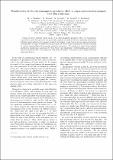Manifestation of the electromagnetic proximity effect in superconductor-ferromagnet thin film structures
View/
Date
13/08/2019Author
Grant ID
EP/I031014/1
EP/J01060X/1
EP/L015110/1
EP/R023522/1
EP/R023522/1
EP/R031924/1
Metadata
Show full item recordAbstract
Using the newly emerged theory model of an electromagnetic proximity effect, we demonstrate that it provides a good description of our previously reported anomalous Meissner screening observed in thin film superconductor-ferromagnet proximity structures. Using the low energy muon spin rotation measurement technique, we further investigate this new theory by probing directly the flux screening in various superconductor-ferromagnet proximity structures. We examine its main characteristics and find in general good agreement between theory and experiment. Understanding and control of this new proximity effect is an important step forward toward a new generation of superconducting spintronic devices.
Citation
Flokstra , M G , Stewart , R , Satchell , N , Burnell , G , Luetkens , H , Prokscha , T , Suter , A , Morenzoni , E , Langridge , S & Lee , S L 2019 , ' Manifestation of the electromagnetic proximity effect in superconductor-ferromagnet thin film structures ' , Applied Physics Letters , vol. 115 , no. 7 , 072602 . https://doi.org/10.1063/1.5114689
Publication
Applied Physics Letters
Status
Peer reviewed
ISSN
0003-6951Type
Journal article
Description
We acknowledge the support of the EPSRC through Grant Nos. EP/I031014/1, EP/J01060X, EP/J010650/1, EP/J010634/1, EP/L015110/1, EP/R031924/1, and EP/R023522/1. This project has received funding from the European Union's Horizon 2020 research and innovation program under the Marie Skłodowska-Curie Grant Agreement No. 743791 (SUPERSPIN).Collections
Items in the St Andrews Research Repository are protected by copyright, with all rights reserved, unless otherwise indicated.
Related items
Showing items related by title, author, creator and subject.
-
Unusual intermolecular “through-space” J couplings in P–Se heterocycles
Sanz Camacho, Paula; Athukorala Arachchige, Kasun Sankalpa; Slawin, Alexandra Martha Zoya; Green, Timothy F.G.; Yates, Jonathan R.; Dawson, Daniel McLean; Woollins, J Derek; Ashbrook, Sharon Elizabeth (2015-05-20) - Journal articleSolid-state NMR spectra of new P–Se heterocycles based on peri-substituted naphthalene motifs show the presence of unusual J couplings between Se and P. These couplings are between atoms in adjacent molecules and occur ... -
Controlling the electromagnetic proximity effect by tuning the mixing between superconducting and ferromagnetic order
Stewart, R.; Flokstra, M. G.; Rogers, M.; Satchell, N.; Burnell, G.; Miller, D.; Luetkens, H.; Prokscha, T.; Suter, A.; Morenzoni, E.; Lee, S. L. (2019-07-12) - Journal articleWe present low-energy muon-spin rotation measurements on Cu/Nb/AlOx/Co thin films that probe the newly described electromagnetic (EM) proximity effect. By varying the thickness of the insulating AlOx layer we control the ... -
Switching on electrocatalytic activity in solid oxide cells
Myung, Jaeha; Neagu, Dragos; Miller, David N.; Irvine, John T. S. (2016-09-22) - Journal articleSolid oxide cells (SOCs) can operate with high efficiency in two ways—as fuel cells, oxidizing a fuel to produce electricity, and as electrolysis cells, electrolysing water to produce hydrogen and oxygen gases. Ideally, ...

